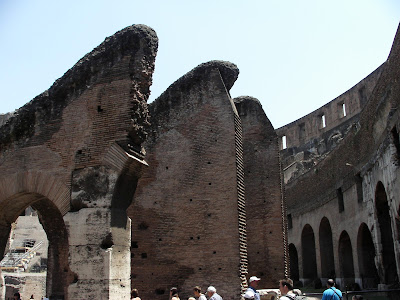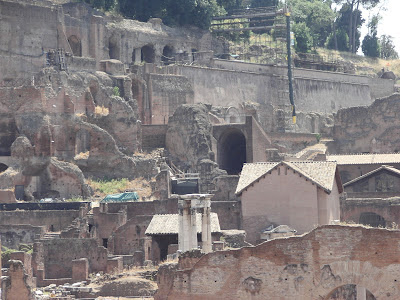The Colosseum – Roma
 |
| The Colosseum |
Words and photography by Allison O’Donoghue
It is impossible to
state in words just how extraordinary this building really is. The iconic
structure of Rome was nearly lost to weather erosion, looting and constant
earthquake damage until Pope Benedict XV consecrated the site in honor of all
the Christians slaughtered in the name of entertainment. The people of Rome
rallied in 1750 to save the site for all time and we tourists are the lucky
recipients of the continual preservation of the colossus that is the
Colosseum. Albeit this did not
stop people looting the site, rumour has it, many Romans have a wall or BBQ
area made from the bricks of the Colosseum or a massive foot in their backyard.
The Italian government put a stop to this custom in the 1950’s and to this day
the Colosseum is guarded overnight.
 |
| Christian Cross |
Disembarking from the
Colosseum metro station, I take the escalator to the top and as I slowly rise I
begin to see a partial view of the enormousness of the Colosseum. And what a
view!
No matter how many
documentaries I’ve watched on this amazing building, nothing prepares you for
the real thing.
Initially, I was put
off by the long queues waiting patiently in the heat to get in and was nearly
tempted to buy an overpriced ticket 50 euro ($110 AUD) from the “skip the queues”
spruikers out the front vying for your business, offering fast track guided
tours. However, this is not necessary, the queue moves very quickly and
efficiently and you can buy an audio-guided tour that is just as informative as
the personal approach for 15 eruo ($38 AUD).
This grand monument
was commissioned by Vaspasian and inaugurated by his son Titus in 80 AD
originally named Flavian Amphitheatre and is a technological masterpiece. Built
out of travertine tufa, brick and the new invention, cement, as an
entertainment venue for the starving Romans to distract them from their
rumbling tummies. The Colosseum is a tour de force in terms of construction,
156 metres long, 527 metres in circumference and four storeys high holding an
audience of over 50,000 above ground, and another 20,000 underground. Three
storeys of arches divide columns in various styles, Doric, Ionian and
Corinthian. The archless fourth storey was decorated with Corinthian lace and
had a covering system that sheltered spectators from the rain and hot sun. Of
course, the cover no longer exists and the walls are slowly crumbling, however
all efforts are made to shore up the structure for posterity.
As you walk through
one of the four main entrances the enormity of the Colosseum swallows you whole. It is huge and an aura of grandeur
hovers over the arena. Maybe it’s images of the film Gladiator that makes this place come alive in my mind, but looking
at the podium where the Emperor and his cohorts sat, I’m tempted to put my
thumbs up.
 |
| Modern day Gladiator |
The centre floor of
the Colosseum has gone, revealing the bowels and operational tunnels and
corridors of the arena. Gladiators and beasts roamed this area awaiting their
death or triumph. In the case of the beasts, death was assured, to such an
extent that some species came close to extinction.
 |
| Beasts in the house |
You can still see
where the masses sat. Like our own sporting arenas, modelled on the Colosseum,
there was a hierarchy system to the seating arrangements. The general public
sat on three ranges of front seats, the interior sat the masses, the centre sat
the knights and the upper decks sat the aristocrats. There was also a standing
room only area where the very poor stood for hours on end, but they were in a
prime position to catch the bread and fruit thrown out to the crowd by the
grace of the Emperor, sometimes it was the only meal they had for the day.
There were 80 numbered
arcades selling all manner of wares, fast food, wine, produce and souvenirs but
only remnants of these arcades remain. On the third floor is now the museum and
gift shop, absolutely worth visiting. Rescued ancient artefacts, sculptures and
tablets are displayed here, and even better entry is included in the price. The
gift shop sells mass manufactured trinkets that will still be sold in years to
come but if you only plan on visiting once then grab your souvenirs from here.
You can buy a 100ml bottle of olive oil for 100 ($210) per bottle made directly from the
2000yr old olive trees that still line the street running alongside the
Colosseum.
From this vantage
point, you can see the full scale of the Arch of Constantine built by the
Senate to celebrate the victory against Maxentius in 313 AD and is the
best-preserved triumphal arch in Rome, built with fragments from other ancient
monuments and temples of Trajan, Adrian and Marcus Aurelius. You can also see
the horse and chariot parking spaces running adjacent to the Arch.
 |
| Roman Forum - Via Scara |
 |
| Excavation site |
Looking down the Via
Sacra you get a glimpse of the Roman Forum and an archaeological dig in
progress. For the price of admission and a hard hat you can watch at close
range as archaeologists and students from all over the world dig up ancient
artefacts right before your eyes. To this day Rome is still offering up its
history and magnificence. Every time the council decides to clear an area to
construct a new building or car park, the earth closes down the project due to
its historical significance.
Roman Forum
The Greeks and Etruscans used the Forum as a market place until the Romans used the area as a gathering place for communal meetings and centre of government in 753BC. Walk along the Via Scara one of the oldest streets in Roma which leads to the Arch of Titus. This is site is a ruin now but well detailed maps point out buildings and there use. The Forum was a buzzing environment where Romans could speak from the Rostra the speakers platform erected by Julius Caesar in 44 BC. the market square is surrounded by a number of shrines like the Lapis Niger - Black Stone the site where Romulus was supposedly murdered by Republican senators. The oldest known Latin inscription in Roma is located on the underground 6th century ruins close to the Black Stone. The Temple of Saturn located in the lower section of the Forum was renowned for its wild Roman parties during Roma's Golden Age. The Temple of Vesta is where the Vestal virgins kept the scared flame lit for over 1000 years. They lived in the House of the Vestal Virgin in seclusion for 30 years and it was a great honour for a Roman family if their daughter was chosen at the age of seven to enter the Vestal Virgin house.
 |
| Via Scara |
 |
| Fori Imperiali |
 |
| Fori Imperali |
 |
| Roman Forum |
 |
| Julius Caesar |
 |
| Roman Forum |
 |
| Trajan's Column |
 |
| Fori Imperaili |
Fori Imperiali
This area is closed for excavations. It seems several dig areas are closed to the public, whenever the Roma council want to build a new road they discover more ancient ruins and no progress can be made until the site has been excavated for historical importance. However you can see Trajan's Column very clearly. One of the greatest examples of Roman relief sculpture. Built between AD 107 - 113 the Fori Imperiali included the Forum of Trajan where a colossal equestrian statue of Trajan and triumphal arch was built in his honour until St Peter replaced Trajan in 1588. The grey wall of the Forum of Augustus commemorates Augustus victory over Caesar's murderer's in 42 BC. The only remnant left of Vespasian's Forum is the mosaic of Chiesa della Santi Cosma e Damiano across the Via Covour near the Roman Forum.
 |
| Trajan's Column |
In spite of 20
centuries of deterioration the Colosseum still has the grandeur and splendour of
Roman greatness. The fact that it is still standing 2000 years later is a
testament to the engineers and their ‘modern’ techniques that are copied and
imitated to this day.
According to an
ancient prophecy ‘the end of the
Colosseum is bound to be the end of Rome and the end of Rome to that of the
world’. Well they were the masters of the universe at the time. Maybe it’s
within everyone’s interest to preserve this amazing building for the survival
of us all.
www.rome.info.com
www.aviewoncities.com
www.italyguides.it
www.colosseum.net
www.tickitaly.com
www.rome.info.com
www.aviewoncities.com
www.italyguides.it
www.colosseum.net
www.tickitaly.com
 |
| Wild beasts still roam the Colosseum |
 |
| Underbelly of the Colosseum |
 |
| Arc of Constantine |




















1 comment:
Nice snaps you have shared.I simply loved it.
Post a Comment